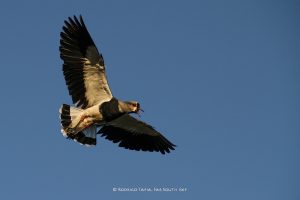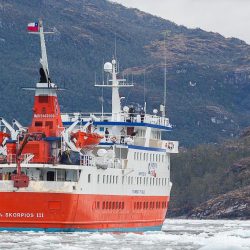King Penguins in Tierra del Fuego.
Shaped by time and the forces of Evolution into the ultimate swimmers and divers in the avian world, the family of Penguins has always spiked the curiosity of man, maybe partly due to their vaguely humanoid upright bipedal walking posture, but also due to their command of swimming and diving, which truly makes them creatures of the sea that only come to land to breed.

Showing off their colourful feathery coats, a trio of adult Kings rest in the sun. Their dense, waterproof feathering insulates and protects them from both the chilling wind and the cold water, and enables them to spend hours diving for food at sea. © Claudio F. Vidal, Far South Exp
The eighteen species of modern penguins live across the oceans of the Southern hemisphere and although a few are distributed in subtropical and even tropical areas, and other few in the Antarctic, most penguin species live in the cold, temperate waters of the Sub Antarctic region.

The colourful patterns of head, beak and throat can give a rough idea about a penguin´s age group, and along with vocalizations, probably play an important role in attracting and courting a mate. © Claudio F. Vidal, Far South Exp
This is the case of the King Penguin, Aptenodytes patagonicus, which breeds on sub Antarctic islands and used to breed in the southernmost tip of the South American continent in the past.

A general view of the small continental colony at Tierra del Fuego, with predominantly adult birds among the tussock grass of the riverbank. © Enrique Couve, Far South Exp

Swimming and playing around in the freshwater stream, two adults take advantage of the proximity of the river and go for a refreshing bath. © Rodrigo Tapia, Far South Exp
One of the two members of genus Aptenodytes, the large penguins, it is, at 90cm and 15kg, second only to the Emperor in size among all penguin species. It feeds mainly on small fish and squid of the cold Southern Ocean, and may breed any time in the year, producing two offspring every three years. This unique breeding cycle results in the fact that penguins of all ages may be present at a time in colonies of this species.
The small colony of Bahia Inútil in Tierra del Fuego, Chile, with over a hundred birds, is but a tiny fraction of the species total estimated population of around six million birds, but is the only continental breeding site in the world, hence its importance and singularity.

King penguins mate and breed year-round, showing no marked preference for any particular season, and they produce two offspring over a three-year lapse. © Enrique Couve, Far South Exp
The colony is located in private, protected land, close to a river mouth, and the river is sometimes used as an access to the sea by the penguins, which is also a peculiarity of this particular colony. It is however this same river which makes it easy for some predators to reach the colony and prey upon eggs and chicks, this is clearly the case of the biggest menace, the mink, a harmful exotic carnivore that has spread across the southern tip of the American continent, and feral dogs and even native foxes, fairly common in the area, should be regarded as potential threats.
The colony is believed to have been here already in the prehistory, as remains of both King and Magellanic penguin have been found in archaeological sites and excavations of human settlements dated more than six thousand years ago in the area.

Still covered in its warm brown downy coat, a chick is looked after and fed by both parents who take turns in their foraging and food-gathering expeditions. © Enrique Couve, Far South Exp
Later, between the XVIIIth and XIXth centuries, this colony was abandoned probably due to the destruction of the habitat as this land was mostly converted to sheep farming, and its existence remained largely unknown up until some 10 years ago, when penguins started to beach and stay around for long periods in increasing numbers, until present day when there are permanently more than a hundred penguins and pairs have started producing offspring.
If you feel like spending some time with these beautiful birds, check out our programme to go see them in their grounds in their only continental breeding site.
King Penguins in Tierra del Fuego. Click here for further details.

Approaching the river at sunset for bathing, some Kings move to the periphery of the colony to access the stream. © Rodrigo Tapia, Far South Exp
Learn more about Birding in Chile. Read article.



















Leave a Reply
Your email is safe with us.